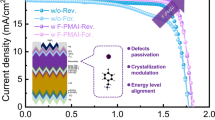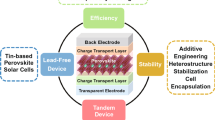Abstract
In this paper, A modified one-step method was used to prepare the CH3NH3PbI3 (MAPbI3) perovskite film, and the planar heterojunction perovskite solar cells (PHPSCs) were assembled by optimizing the preparation process of the TiO2 compact layer (c-layer) and perovskite film. A TiO2 c-layer as the electron transfer layers (ETLs) was controlled by the spin coating method with the different TiO2 precursor solution and the number of spin coating. The perovskite layer, as a light absorption layer, was obtained by spin coating on the TiO2 c-layer with MAPbI3 precursor solutions of different mass concentrations. The characterization results show that although the preparation process is different, the surface morphology of TiO2 c-layer and perovskite layer are not very different, but there are some fluctuations in the thickness and internal structure of their films. The planar solar cell devices with c-TiO2/MAPbI3/HTM/Ag structure showed different photoelectric conversion performance. By optimizing the preparation process, the photoelectric conversion efficiency of the assembled solar cell device can reach 12.11% based on a TiO2 c-layer obtained by two-spin coating with 0.1 M precursor solution and the perovskite layer obtained by spin coating with a mass concentration of 45% in MAPbI3 solution.

Highlights
-
Figure 1 Diagram of the perovskite film deposited on the TiO2 c-layer by a modified one-step method.
-
Figure 3a SEM images of a TiO2 c-layer of 0.1–2T indicates that the TiO2 c-layer has smooth surface morphology.
-
Figure 11c SEM images prepared with 45 wt% mass concentrations of MAPbI3 solutions on the TiO2 c-layer of two coating.














Similar content being viewed by others
References
Burschka J, Pellet N, Moon SJ, Humphry-Baker R, Gao P, Nazeeruddin MK, Grätzel M (2013) Sequential deposition as a route to high-performance perovskite-sensitized solar cells. Nature 499:316–319. https://doi.org/10.1038/nature12340
Shao Y, Xiao Z, Bi C, Yuan Y, Huang J (2014) Origin and elimination of photocurrent hysteresis by fullerene passivation in CH3NH3PbI3 planar heterojunction solar cells. Nat Commun 5:1–7. https://doi.org/10.1038/ncomms6784
Xia G, Liu H, Zhao X, Dong X, Wang S, Li X (2019) Seeding-method-processed anatase TiO2 film at low temperature for efficient planar perovskite solar cell. Chem Eng J 370:1111–1118. https://doi.org/10.1016/j.cej.2019.03.257
Hui W, Chao L, Lu H, Xia F, Wei Q, Su Z, Niu T, Tao L, Du B, Li D, Wang Y, Dong H, Zuo S, Li B, Shi W, Ran X, Li P, Zhang H, Wu Z, Ran C, Song L, Xing G, Gao X, Zhang J, Xia Y, Chen Y, Huang W (2021) Stabilizing black-phase formamidinium perovskite formation at room temperature and high humidity. Science 371:1359–1364. https://doi.org/10.1126/science.abf7652
Pylnev M, Sen Su T, Wei TC (2021) Titania augmented with TiI4 as electron transporting layer for perovskite solar cells. Appl Surf Sci 549:149224. https://doi.org/10.1016/j.apsusc.2021.149224
Yue S, Wu G, Li X, Li K, Huang G, Tang Y, Zhou H (2021) Research progress of quasi-two-dimensional perovskite solar cells. Gaodeng Xuexiao Huaxue Xuebao/Chemical J Chin Univ 42:1648–1671. https://doi.org/10.7503/cjcu20200863
Rolston N, Bush KA, Printz AD, Gold-parker A, Ding Y, Toney MF, Mcgehee MD, Dauskardt RH (2018) Engineering stress in perovskite solar cells to improve stability. Adv Energy Mater 1802139:1–7. https://doi.org/10.1002/aenm.201802139
Zhang H, Mao J, He H, Zhang D, Zhu HL, Xie F, Wong KS, Grätzel M, Choy WCH, Smooth A (2015) CH3NH3PbI3 film via a new approach for forming the pbi2 nanostructure together with strategically high CH3NH3I concentration for high efficient planar-heterojunction solar cells. Adv Energy Mater 5:1–10. https://doi.org/10.1002/aenm.201501354
Zaky AA, Christopoulos E, Gkini K, Arfanis MK, Sygellou L, Kaltzoglou A, Stergiou A, Tagmatarchis N, Balis N, Falaras P (2021) Enhancing efficiency and decreasing photocatalytic degradation of perovskite solar cells using a hydrophobic copper-modified titania electron transport layer. Appl Catal B Environ 284:119714. https://doi.org/10.1016/j.apcatb.2020.119714
Na S, Lee S, Choi W, Park C, Ryu SO (2019) Atomic-layer-deposited TiO2 with vapor-grown MAPbI3−xClx for planar perovskite solar cells. J Vac Sci Technol 010902:3–7. https://doi.org/10.1116/1.5052287
Zhou H, Qi C, Gang L, Song L, Tze-bing S, Hsin-Sheng D, Ziruo H, You J, Yongsheng L, Yan Y (2014) Interface engineering of highly efficient perovskite solar cells. Science 345:542–546. https://doi.org/10.1126/science.1254050
Jeon NJ, Noh JH, Kim YC, Yang WS, Ryu S, Il Seok S (2014) Solvent engineering for high-performance inorganic-organic hybrid perovskite solar cells. Nat Mater 13:897–903. https://doi.org/10.1038/nmat4014
Ren X, Wang ZS, Choy WCH (2019) Device physics of the carrier transporting layer in planar perovskite solar cells. Adv Opt Mater 1900407:1–23. https://doi.org/10.1002/adom.201900407
Etgar L, Gao P, Xue Z, Peng Q, Chandiran AK, Liu B, Nazeeruddin MK, Grätzel M (2012) Mesoscopic CH3NH3PbI3/TiO2 heterojunction solar cells. J Am Chem Soc 134:17396–17399. https://doi.org/10.1021/ja307789s
Im JH, Lee CR, Lee JW, Park SW, Park NG (2011) 6.5% Efficient perovskite quantum-dot-sensitized solar cell. Nanoscale 3:4088–4093. https://doi.org/10.1039/c1nr10867k
Eperon GE, Burlakov VM, Docampo P, Goriely A, Snaith HJ* (2014) Morphological control for high performance, solution-processed planar heterojunction perovskite solar cells. Adv Funct Mater 1–31. https://doi.org/10.1002/adfm
Chen J, Park N (2018) Causes and solutions of recombination in perovskite solar cells. Adv Mater 1803019:1–56. https://doi.org/10.1002/adma.201803019
Author information
Authors and Affiliations
Corresponding author
Ethics declarations
Conflict of interest
The authors declare no competing interests.
Additional information
Publisher’s note Springer Nature remains neutral with regard to jurisdictional claims in published maps and institutional affiliations.
Rights and permissions
About this article
Cite this article
Wu, J., Wang, Y., Su, C. et al. Preparation and characterization of planar heterojunction perovskite solar cells based on c-TiO2/CH3NH3PbI3/HTM/Ag structure. J Sol-Gel Sci Technol 100, 440–450 (2021). https://doi.org/10.1007/s10971-021-05682-z
Received:
Accepted:
Published:
Issue Date:
DOI: https://doi.org/10.1007/s10971-021-05682-z




